
Performance of European Partnerships
Biennial Monitoring Report 2022 on partnerships in Horizon Europe
The Biennial Monitoring Report (BMR) aims to provide a strong and continuously evolving evidence base to guide the implementation of European Partnerships throughout their life cycles and to inform strategic discussions on Horizon Europe’s new policy approach to them.
European Partnerships are a key instrument for the implementation of Horizon Europe and the European Research Area. They allow the EU to team up with public and private partners to help speed up new solutions for the green and digital transitions and to strengthen Europe’s resilience.
Contents of the digital report
- On the 2022 BMR edition
- Section I: Partnership portfolio
- Section II: Budget commitments to European Partnerships
- Section III: Partnerships leveraging funding
- Section IV: Partnerships contributing to the twin digital and green transitions, and Europe’s resilience
- Section V: Partnerships contributing to the UN’s Sustainable Development Goals (SDGs)
- Section VI:Partnerships as drivers for deepening the European Research Area
- Section VII: Openness and inclusiveness of Partnerships
- Section VIII: Partnerships as network builders
- Chapter 3: Country fiches
- Chapter 4: European Partnership fiches:
- Downloads
Performance of European Partnerships
On the 2022 BMR edition
The BMR 2022 focuses on Horizon Europe’s new partnership landscape and establishes benchmarks for assessing progress in future reports. BMR 2022 is the first attempt to comprehensively monitor partnerships using a set of common indicators and to analyse their contribution to EU policy objectives and the UN’s Sustainable Development Goals (Chapter 2). It also provides a country-by-country snapshot of the performance of the 27 EU Member States, Iceland, and Norway (Chapter 3), as well as the performance of each European Partnership (Chapter 4).
Notes
- Two cross-cutting themes were selected for this edition: synergies, as European Partnerships are expected to take a more systematic approach for collaborating between themselves, as well as with other R&I initiatives, and ‘expected contribution to the EU priorities of the green and digital transitions and resilience’. Insights related to the selected themes are integrated in the report’s chapters.
- The first BMR is different from the following editions because data on the performance of European Partnerships is still very limited. Therefore, this report provides indicative observations based largely on data collected via the Common Indicators Survey, partnership and country fiches, and Horizon 2020’s data, while future reports will include Horizon Europe’s data.
Section I
Partnership portfolio
European Partnerships have been identified as part of Horizon Europe’s strategic planning and the complementary strategic coordinating process for partnerships involving Member States. BMR 2022 covers 37 European Partnerships officially launched at the time of publishing this report. The number of Horizon Europe partnerships is expected to reach 49 by the time all currently planned partnerships have officially been launched under the first Strategic Plan under Horizon Europe (2021-2024).
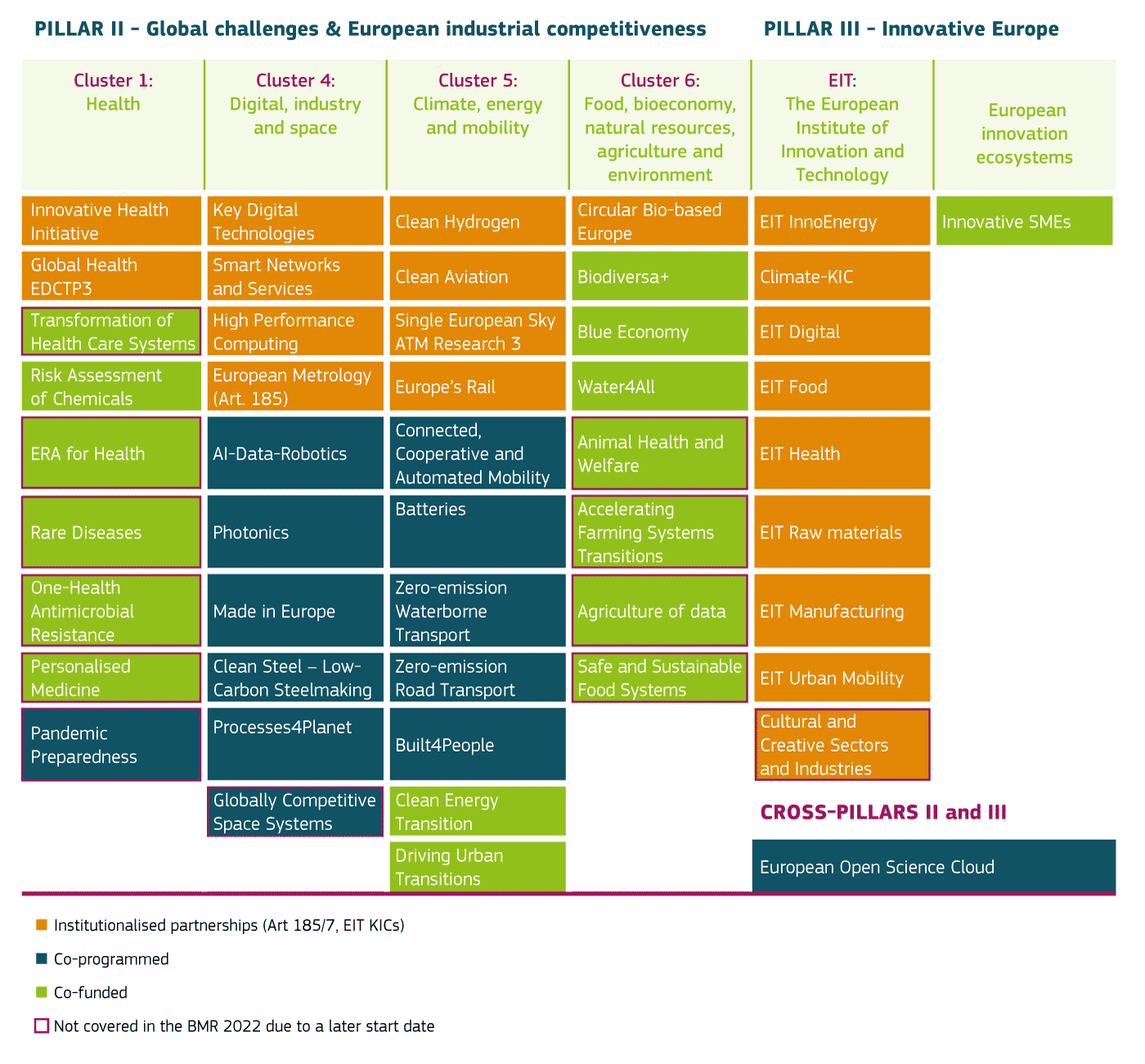
The extensive reform and rationalisation of partnerships entailed reducing the number to 49, compared to almost 120 partnerships under Horizon 2020. Under Horizon Europe, European Partnerships may only be set up in three different forms: co-funded, co-programmed and institutionalised.
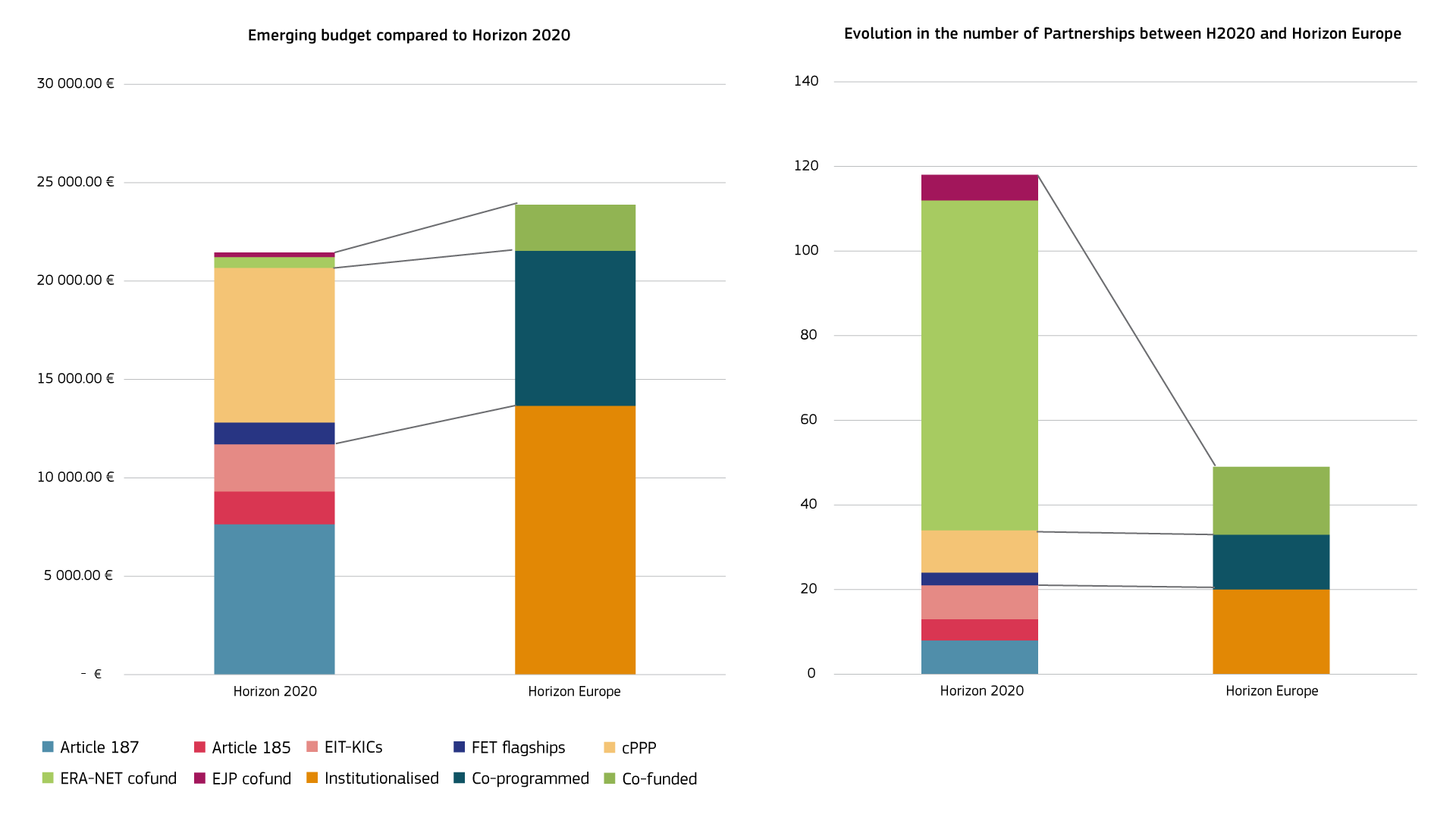
Many partnerships funded under Horizon 2020 continue their activities beyond the end of Horizon 2020 – e.g. many ERA-NETs, Joint Programming Initiatives (JPIs) and the Partnership on Research and Innovation in the Mediterranean Area (PRIMA) will implement calls until 2024. Others, even though no longer launching calls, will still be ending their activities and winding down operations. Consequently – as shown below – the total number of active partnerships (in both Horizon 2020 and Horizon Europe) peaked with the launch of European Partnerships in 2021 and a significant decrease will only happen towards the middle of Horizon Europe. While the number of European Partnerships is known for 2021-2024, it may increase from 2025 onwards, depending on discussions on the second Strategic Plan for Horizon Europe.
Source: European Commission supported by ERA-LEARN
Section II
Budget commitments to European Partnerships
For the 49 European Partnerships in the first Horizon Europe Strategic Plan, a total of EUR 55.3 billion has been committed, of which EUR 23.9 billion from Horizon Europe and EUR 31.4 billion from the partners other than the Union.
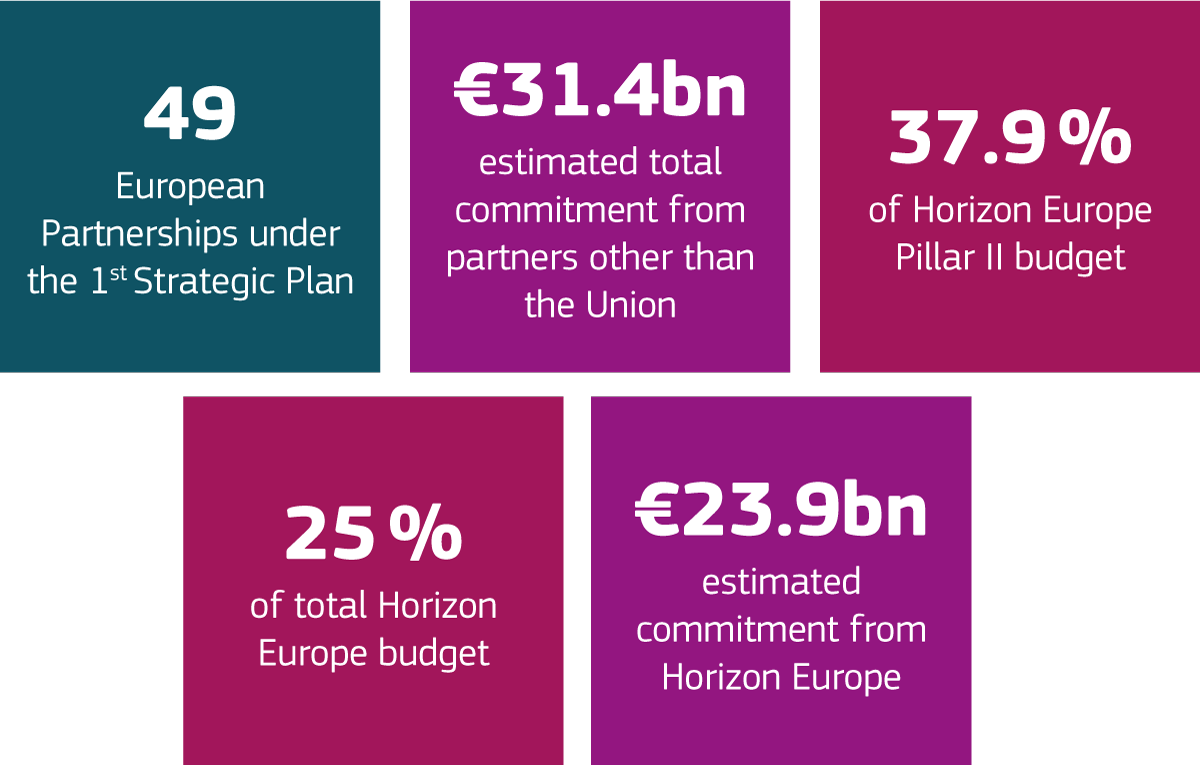
Horizon Europe budget split per type of partnership
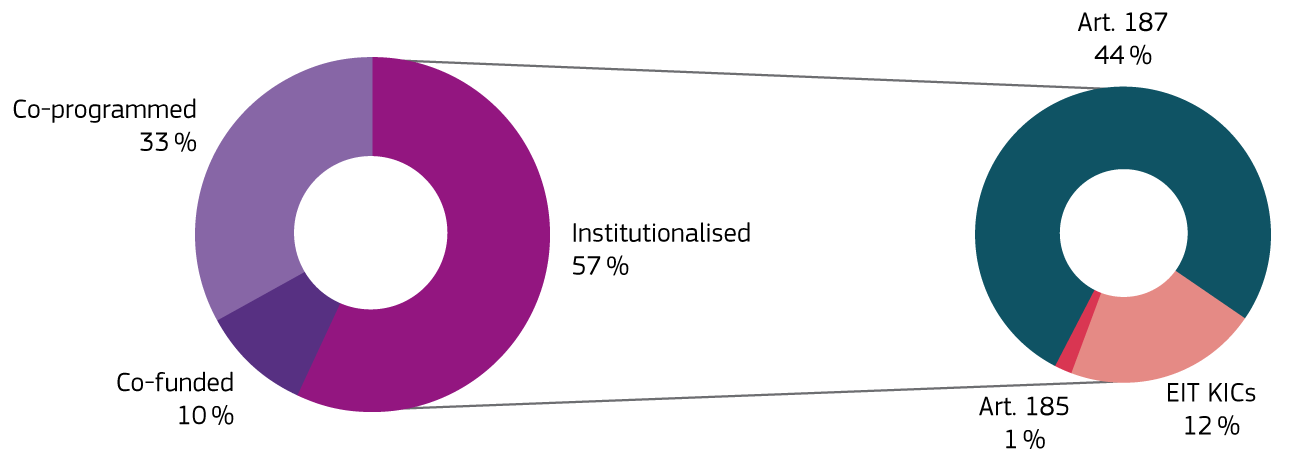
Section III
Partnerships leveraging funding
Member States and Associated Countries have committed EUR 9 billion to the first public partnerships launched under Horizon Europe. Considering that the initial national contributions earmarked by Member States and Associated Countries for partnership calls during Horizon 2020 was around EUR 3 billion, this is a remarkable achievement. It is only comparable to the estimated actual investment made in calls since 2004, including the EU’s contribution, which reaches some EUR 9 billion (read more).
Industry has committed EUR 22.4 billion to the launched European Partnerships. This exceeds by EUR 4.9 billion the requirement to match the EU’s contribution for the co-programmed partnerships and joint undertakings.
Section IV
Partnerships contributing to the twin digital and green transitions, and Europe’s resilience.
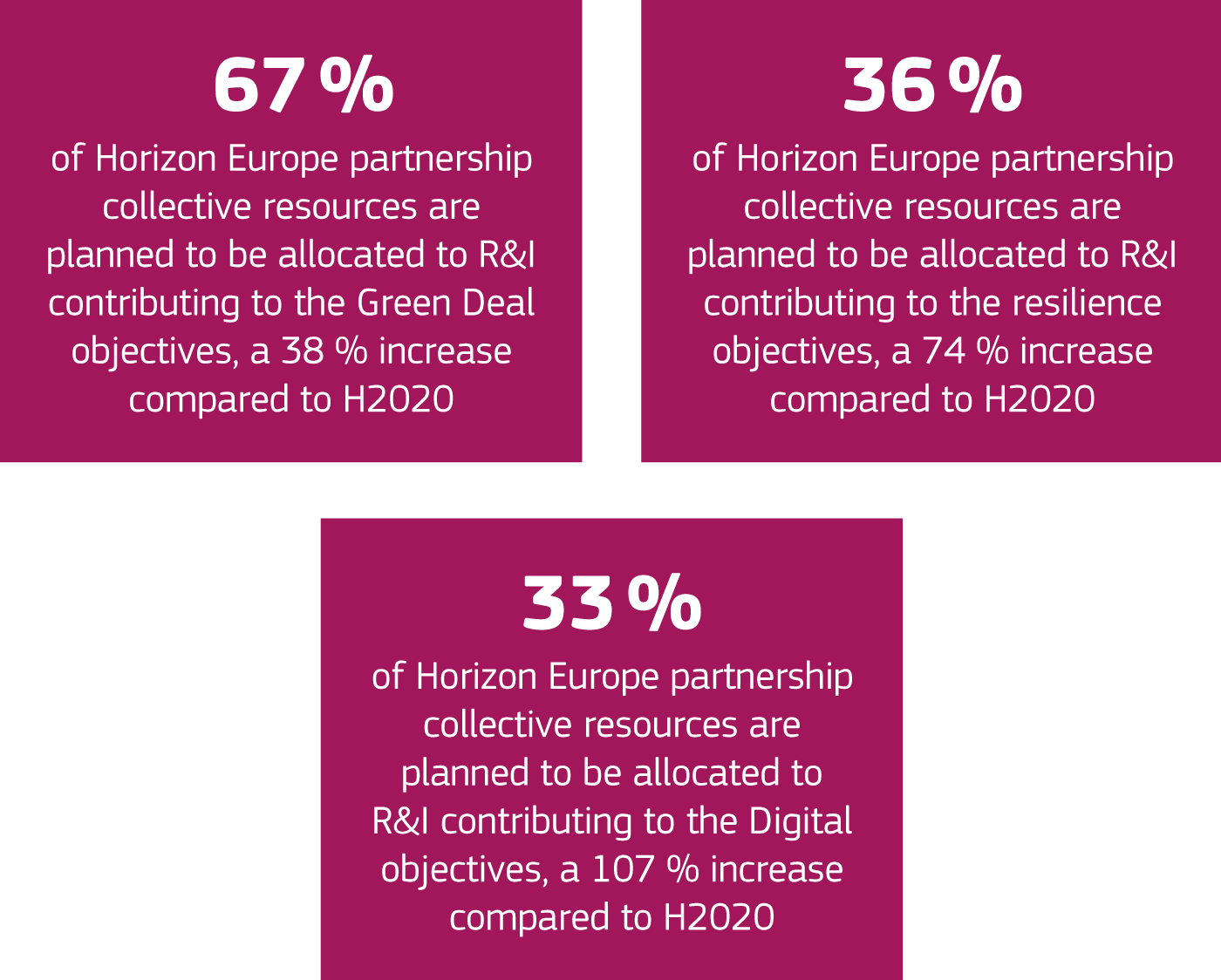
Note: resources can contribute to several objectives at the same time, resulting in a total exceeding 100%.
The BMR 2022 shows the multidisciplinary way in which these priorities are being addressed in European Partnerships and therefore the clear potential for synergies and cooperation between partnerships across clusters. The figures in this section show the contribution of European Partnerships to Green deal, digital transition and health-related resilience.
In the partnership fiches (Chapter 4 of the report) read more about the past success stories or the future intentions of partnerships to establish synergies with European, national and regional initiatives.
Section V
Partnerships contributing to the UN’s Sustainable Development Goals (SDGs)
European Partnerships address in particular the following SDGs:

Section VI
Partnerships as drivers for deepening the European Research Area
Member States recognise the value of partnerships by showing increased interest and commitments in the Horizon Europe partnerships.
Acknowledging the value of Horizon Europe partnerships as more strategic policy instruments marks a difference from the way in which the first partnerships were perceived during Framework Programme 6 and Framework Programme 7, when they were merely considered as an additional funding source.
Under Horizon 2020, the partnerships have led to a variety of impacts at national level going beyond those created by the transnational collaboration in R&I. These include structural impacts improving the national R&I governance system, as well as dedicated funding structures and tools enriching the national portfolios. Some partnerships have also been instrumental in improving the capacity of certain countries in relation to infrastructures. This is particularly important for the less-advanced countries.
Section VII
Openness and inclusiveness of partnerships
European Partnerships demonstrate a strong awareness for improving openness, setting up dedicated measures for newcomers and an interest in reaching out to widening countries in Europe as shown in the graph below. Most partnerships have planned measures for involving various types of stakeholders and countries. Reoccurring planned measures for several partnerships were stakeholder fora, open events, open calls, and activities in new countries.
Partnerships are open for collaboration beyond the EU. When asked which newcomer non-EU countries partnerships target as partners, Norway and Israel were most often mentioned, alongside some African countries. Some partnerships also included Brazil, Canada, China, Chile, India, and the USA in their answers.
Horizon 2020 data shows that partnerships differ as regards the beneficiary types they attract. European Institute of Innovation and Technology Knowledge and Innovation Communities (EIT KICs) and public-public partnerships (P2Ps), like the other Horizon 2020 instruments, address the full spectrum (higher education institutes, private for-profit companies, research organisations and, to a limited extent, public bodies), whereas projects supported by joint undertakings (JUs) and contractual public-private partnerships (cPPPs) are dominated by private for-profit entities.
Horizon 2020 data shows also that not many countries take the leading role of coordinating a partnership, the lack of administrative resources being the main reason here. This role is distributed among the most active countries, i.e. France, Germany, the Netherlands, Austria and Spain.
Section VIII
Partnerships as network builders
European Partnerships intend to establish numerous collaboration links between themselves. The central position of partnerships such as EIT Climate-KIC and AI, Data and Robotics stand out with the largest number of planned coordinated and joint activities with other partnerships.
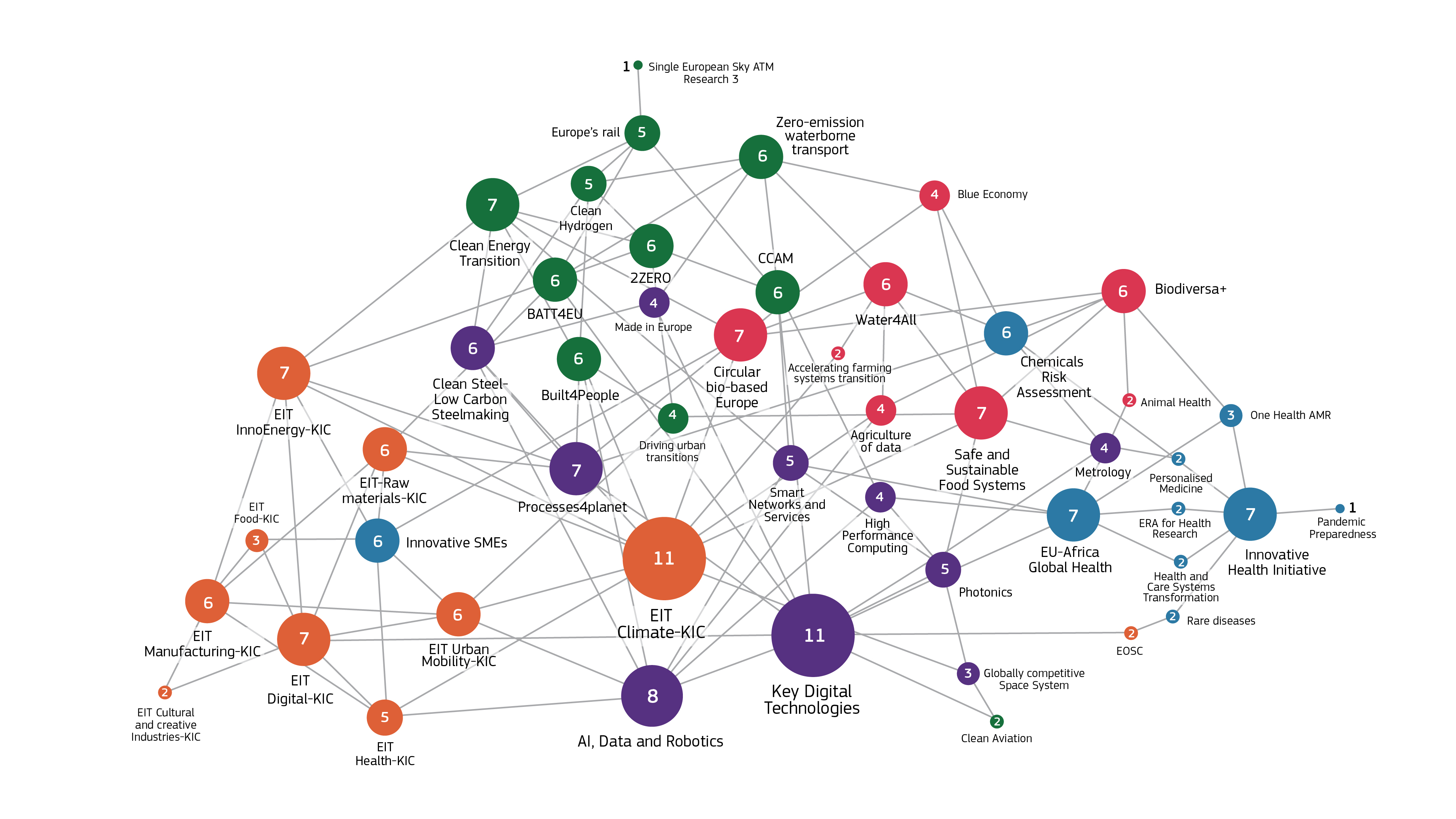
Source: Common Indicators Survey, November 2021

